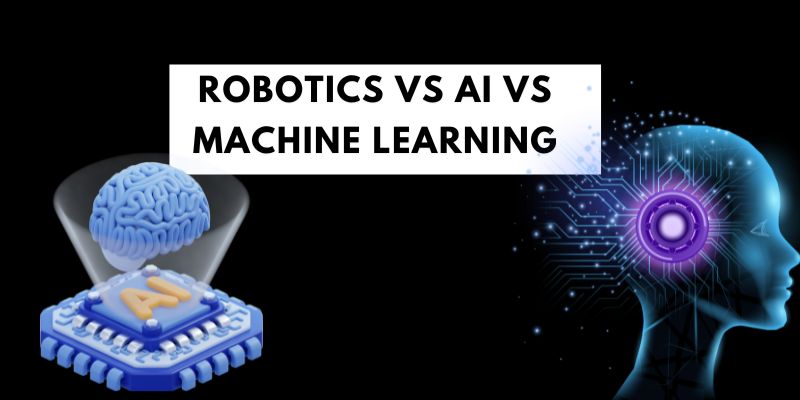In today’s fast-evolving technological landscape, terms like robotics, AI (Artificial Intelligence), and machine learning are often mentioned together, yet their meanings and applications are distinct. While all three play pivotal roles in shaping the future, they serve different purposes and operate in unique ways. Let’s dive into robotics vs AI vs machine learning to explore what sets them apart and how they intersect, providing clarity for anyone curious about these cutting-edge fields.
Robotics – The World of Physical Machines
Robotics is the branch of technology focused on designing, building, and operating robots—programmable machines capable of performing specific tasks either autonomously or semi-autonomously. What makes robotics stand out in the comparison of robotics vs AI vs machine learning is its emphasis on physical interaction with the world, enabled by sensors (to perceive the environment) and actuators (to move or manipulate objects).
Not all robots are “smart.” Many operate on pre-programmed instructions without the need for intelligence. For instance, a factory assembly-line robot repeats the same motions tirelessly, while a basic Roomba vacuum navigates a room without advanced learning capabilities. The primary goal of robotics is to automate physical tasks, making processes more efficient and reducing human effort. Examples include surgical robots controlled by doctors or industrial robots welding car parts.
AI – Mimicking Human Intelligence
In contrast, AI (Artificial Intelligence) is a field of computer science dedicated to creating systems or software that replicate human-like intelligence. Unlike robotics, AI doesn’t require a physical form—it thrives on data and algorithms. AI systems can perform tasks such as reasoning, recognizing patterns, understanding language, or making decisions, often in ways that feel intuitive or “smart.”
When exploring robotics vs AI vs machine learning, AI shines with its ability to handle complex, cognitive challenges. Think of virtual assistants like Siri, facial recognition software, or recommendation engines on platforms like Netflix—all powered by AI. The objective of AI is to develop intelligent systems that can support or even replace human decision-making in diverse scenarios, from customer service chatbots to weather forecasting tools.
Machine Learning – Learning from Data
Machine Learning, a subset of AI, focuses on building algorithms that allow computers to learn from data and improve over time without explicit programming. Rather than following step-by-step instructions, machine learning models “train” on datasets to make predictions or decisions based on patterns they uncover.
In the context of robotics vs AI vs machine learning, machine learning is the engine that powers much of AI’s intelligence. For example, an email spam filter learns to identify junk mail by analyzing millions of examples, while a handwriting recognition system refines its accuracy with practice. Machine learning includes approaches like supervised learning (using labeled data), unsupervised learning (finding hidden patterns), and reinforcement learning (learning through trial and error). Its goal is to enable machines to adapt and optimize their performance autonomously.

Robotics vs AI vs Machine Learning: A Side-by-Side Comparison
To better grasp how these fields differ, here’s a concise comparison:
| Aspect | Robotics | AI | Machine Learning |
|---|---|---|---|
| Nature | Physical machines | Software/Algorithms | Data-driven algorithms |
| Goal | Automate physical tasks | Simulate human intelligence | Learn and predict from data |
| Standalone Use | Yes (robots without AI) | Yes (AI without robots) | Typically part of AI |
| Interaction | With the physical world | With data and information | With data for training |
How They Connect
While distinct, robotics vs AI vs machine learning reveals fascinating overlaps:
AI and Robotics: AI can enhance robots, making them “smarter.” For instance, a modern Roomba might use AI to detect and avoid obstacles like pet waste. However, not all robots need AI—many function perfectly with basic programming—and AI doesn’t require a robotic body to operate.
Machine Learning and AI: Machine learning is a key tool for realizing AI’s potential, enabling systems to learn and adapt. It’s the “how” behind much of AI’s “what.”
Machine Learning and Robotics: When integrated into robotics, machine learning allows robots to improve tasks over time. A robotic arm, for example, might use machine learning to sort objects more accurately by analyzing camera data.
Real-World Examples
- Robotics without AI: A factory robot arm programmed to weld car frames in a fixed pattern.
- Robotics with AI/ML: An advanced Roomba using machine learning to map a home and avoid obstacles dynamically.
- AI/ML without Robotics: Alexa processing voice commands with AI and machine learning, no physical robot required.
Understanding robotics vs AI vs machine learning is more than an academic exercise—it’s a window into how technology transforms our lives. Robotics automates the physical, AI powers the intellectual, and machine learning fuels the learning process behind it all. Together or apart, they’re driving innovations from self-driving cars to personalized healthcare.
Next time you hear these terms, you’ll know exactly where they fit—and how they might just be working together to shape the future.

